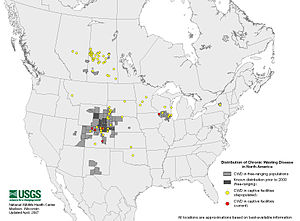 |
| Image via Wikipedia |
State wildlife officials will again be collecting deer tissue samples looking for the presence of Chronic Wasting Disease in the Iowa herd.
The Iowa Department of Natural Resources began monitoring for the disease in 2000 and since CWD was found in Wisconsin and Illinois near the Iowa border in 2002, a majority of samples had been collected from counties along the Mississippi River.
Recent confirmed cases of CWD in a wild deer near Pine Island, Minn., and captive deer in Linn County, Mo., has the DNR increasing the number of samples from Howard, Mitchell, and Winneshiek counties in the north and Appanoose and Wayne counties in the south.
“Chronic wasting disease has been confirmed in every state bordering Iowa but so far, we have not had a sample come back positive,” said Dale Garner, chief of the Iowa DNR’s Wildlife Bureau.
Wildlife staffers have been collecting samples since September, but most of the samples come during the shotgun seasons when most of the deer are harvested. Garner said 94 percent of the tissue samples were from hunter harvested deer that were volunteered at check stations, hanging sheds and meat lockers. Samples are collected from every county, with a statewide goal of 4,500.
“Hunters have been our partners in this monitoring effort and we appreciate their willingness to work with us,” he said. Samples are sent to a USDA certified lab for testing.
What is Chronic Wasting Disease?
Chronic Wasting Disease is a brain disease that can infect deer, elk, and moose and is classed as a spongiform encephalopathy. An abnormal protein agent, called a prion, causes normal proteins of the brain to take on a different shape and form microscopic holes in the brains of infected animals. The disease is always fatal, although it may remain dormant within an infected animal for long periods of time.
In the later stages of the disease, animals will appear severely emaciated, lethargic, and display repetitive behaviors. Excessive thirst and salivation, tremors, extreme behavioral changes, and drooping head and ears are also often displayed.
Anyone observing a deer displaying these symptoms should immediately contact the Iowa DNR.
To date, there is no evidence that humans can contract CWD by eating venison. However, the National Institute of Health and Centers for Disease Control and Prevention recommend that hunters (especially hunters hunting in areas where CWD is known to occur) do not eat the brain, eyeballs, or spinal cord of deer, that hunters wear protective gloves while field dressing game, and bone out meat for consumption.


No comments:
Post a Comment